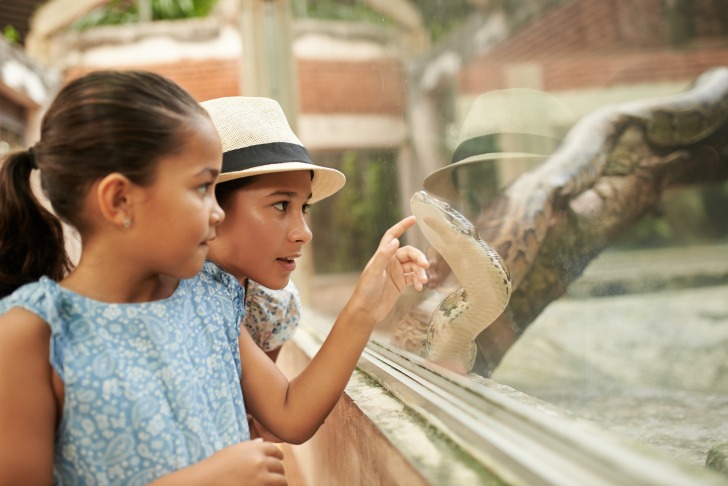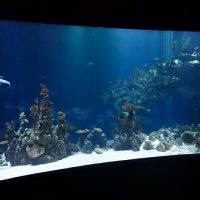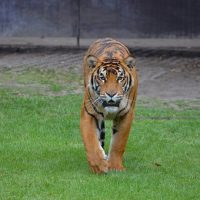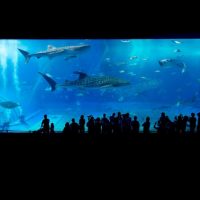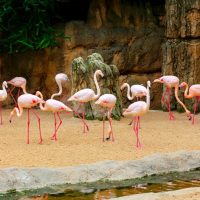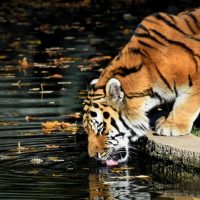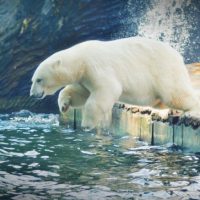Iceland is an island born of fire and ice.
This small North Atlantic island nation consists of extreme weather, dramatic landscapes, and inescapable raw beauty.
Its glaciers, including Europe’s largest Vatnajokull, are protected parks.
And the main island sits on top of an extensive volcanic system.
Iceland has three primary and active volcanoes – the dangerously powerful Katla, Geldingadalur, and Fagradalsfjall.
The Eldgjá fissures also fuel the country’s geysers, hot springs, and active lava fields.
Surprisingly, these dangerous formations also provide geothermal power – running Reykjavik’s capital city.
With such a unique geological and paleontological history, it is only natural that several zoos, animal sanctuaries, and aquariums exist throughout the Icelandic countryside.
Contents
8 Best Zoos & Aquariums in Iceland
SEA LIFE Trust Beluga Whale Sanctuary
The Sea Life Trust Beluga Whale Sanctuary is the world’s first whale sanctuary.
Originally home to Little White and Little Grey, two Beluga Whales.
The sea sanctuary successfully relocated the rare mammals to Klettsvik Bay.
This natural bay area is located on Vestmannaeyjar island, off the south coast of Iceland.
The Klettsvik Bay sanctuary is a few minutes from Vestmannaeyjar Harbour and the SEA LIFE Visitors Center Marine museum.
They are both open to the public from April to October.
The museum houses numerous exhibits that detail the area’s history and types of marine life.
It also dedicates an exhibition to the history of Beluga Whales.
In particular, it is a documentary highlighting the journey from China of Little White and Little Grey.
Visitors can take a boat tour into the bay to chat with the happy pair, wander the marine exhibit, or visit with rescued Puffins who are permanent aquarium residents.
Sæheimar Aquarium
Sæheimar opened in 1964 and is located in Vestmannaeyjabær on Heimsay Island.
This simple white building holds a unique mix of items detailing the area’s geography and marine and animal life.
The museum is known by several names, including the Aquarium and Museum of Natural History of Vestmannaeyjar or its most recent partner, the SEA LIFE Trust.
Saeheimar is separated into natural history exhibits and an aquarium.
The rescued Puffins, previously housed at the museum, now live at the SEA LIFE Sanctuary in Vestmannaeyjar Harbour.
The Sæheimar museum houses a large bird exhibit, including a history of Iceland’s national bird — the gyrfalcon.
This extraordinary bird of prey symbolizes freedom to the Nordic people.
The location also houses a unique geologic and volcanic exhibition.
The aquarium consists of 12 large fish tanks holding Nordic fish, including the rare sea devil and the enormous catfish-like North Atlantic wolffish.
Open year-round with varying summer and winter schedules, Saeheimar Aquarium is a fantastic place for solo travelers or the entire family.
Reykjavik Family Park and Zoo
Iceland’s zoos are dedicated to the preservation and protection of local animals.
And Reykjavik Park and Zoo are no different.
Located in the center of the capital city, the Family Park & Zoo has something for everyone.
There are two separate zoos within Reykjavik Park: a land animal and a marine area.
There is also a small science park where children can play and learn about the environment.
This intimate space is open daily throughout the year and houses Arctic foxes, mink, goats, cattle, sheep, and cats.
There are even rescued Harbor seals in the water enclosure.
There are classes for young children.
And visitors can grab a bite to eat while enjoying the indoor and outdoor rides.
The indoor equipment is always available, but the outdoor rides, known to Icelanders as devices, are closed during the deepest winter.
Petting Zoo Daladýrd
Daladyrd is an intimate petting-style Zoo in North Iceland.
It sits about 25 miles from Akureyri, the North’s capital.
The Petting Zoo is housed on a working farm and highlights the various Icelandic animals needed on a farm.
Visitors can visit with rabbits, large horned sheep, horses, Icelandic goats, and Brahma chickens.
Local cats and kittens always wander their domain.
Sometimes the zoo houses rescued Icelandic foxes.
The Petting Zoo at Daladyrd is open from February through November and is accessible for a minimal fee.
Although small, the Petting Zoo Dalayrd is an excellent opportunity to interact with area animals.
A craft store sells items from local artists, including the famous Icelandic bracelet, the Lopapeysa.
And for a bit of refueling, there is a cafe on site for waffles and coffee.
Slakki Petting Zoo
Slakki Petting Zoo and Family Park are 60 miles east of Rekyavick and near Olfusa Bay.
This beloved farm zoo, nestled in the romantic Nordic hillside, highlights local farm animals like rabbits, turkeys, Arctic foxes, parrots, waterfowl, and chickens.
Slakki Petting Zoo sits in Laugarás, in southwest Iceland’s famous Golden Circle.
There are many other things to do at the Slakki Petting Zoo besides playing with the animals.
An indoor arcade, game tables, or minigolf course are great family activities.
And the onsite restaurant is the perfect burger and ice cream stop before or after visiting the animals.
The petting zoo is open on weekends.
Holar Farm Minizoo
Located on Iceland’s central western coast, directly north of Reykjavik, and a few miles from Hyammsfjordur Bay sits the Holar Farm Minizoo.
This working farm is an excellent example of Ielandi-style farming.
It has dozens of animals, including Shetland-styled horses, rabbits, guinea pigs, giant Brahma chickens, goats, and even North American turkeys.
Holar Farm also boards and teaches horseback riding.
This family farm is also home to Katla, a world-famous talking raven, and a Netflix documentary star.
Holar Farm is an excellent stop for solo travelers and families and is open to visitors each summer from June to early September.
It is easy to find – directly off Highway 590.
Paved paths throughout connecting the animals and farm make this attraction wheel-chair accessible.
And the Minizoo also provides public facilities.
Sea Life Trust
The SEA LIFE Trust is not a single zoo or aquarium, but it is an essential piece of the marine education and preservation puzzle.
It is an international organization that encourages the development of marine sanctuaries to preserve at-risk species.
In this way, they support many marine zoos and aquariums.
The nonprofit foundation initially created the Iceland sanctuary to provide a protected haven for whales while providing opportunities for observation and research.
It expanded to include the Puffin Rescue Center and the preservation of the Nordic puffin colony.
The Puffin Colonies
Iceland is home to roughly 2 million Puffins.
The tuxedoed Atlantic or common puffin live most of their lives at sea.
These birds are agile both in the air and underwater.
They use their wings as paddles and webbed feet as rudders when swimming.
The world’s largest puffin colony thought to hold over 60% of the bird’s population, occupies the Westman Islands.
This small archipelago on Iceland’s southern coast is only accessible by ferry, helicopter, or boat tour.
Known to Icelanders as lundar, in addition to the main nesting colony, visitors can spot these loveable birds at over a dozen coastal locations.
8 Best Zoos & Aquariums in Iceland – Summary Table
| Zoos & Aquariums | Address |
|---|---|
| SEA LIFE Trust Beluga Whale Sanctuary | Ægisgata 2, 900 Vestmannaeyjar, Iceland. |
| Sæheimar Aquarium | Ægisgata 2, 900 Vestmannaeyjabær, Iceland |
| Reykjavik Family Park and Zoo | 104 Reykjavík, Iceland |
| Petting Zoo Daladýrd | Íllugastaðavegur, 607, Iceland |
| Slakki Petting Zoo | Vesturbyggð 10a, 801 Selfoss, Iceland |
| Holar Farm Minizoo | 371 Búðardalur, Iceland |
| Sea Life Trust | Ægisgata 2, 900 Vestmannaeyjabær, Iceland |
| The Puffin Colonies | Westman Islands |
Iceland Safety Overview
READ THE FULL REPORT: Iceland Safety Review
Safety Index: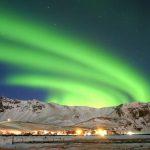
- OVERALL RISK: LOW
- TRANSPORT & TAXIS RISK: LOW
- PICKPOCKETS RISK: LOW
- NATURAL DISASTERS RISK: MEDIUM
- MUGGING RISK: LOW
- TERRORISM RISK: LOW
- SCAMS RISK: LOW
- WOMEN TRAVELERS RISK: LOW
Frequently Asked Questions
How cold does Iceland get?
The extreme lows in this North Atlantic island can reach -22°F (-30°C).
But the average winter temperature sits just below freezing at 32°F (0°C).
While Iceland’s temperatures are reasonable most of the year, the island is very windy, which drops the temperature due to the wind chill effect.
The hottest month in Iceland is July, with an average high of 57°F (14°C), and the coldest months are January and February, with average temperatures hovering around 36°F (2°C).
The rainiest month on the island is usually September averaging five inches.
What is the best month to visit Iceland?
The best time of year to visit Iceland is during the summer months, from mid-June through the end of August.
These are Iceland’s warmest months when the roads are passable, and the streams and waterfalls are unfrozen.
Because of its proximity to the Arctic Circle, June in Iceland has 24 hours a day of sunlight and is a preferred time to visit.
However, this is also considered the high season, and things are more expensive.
Is Iceland an island?
Iceland is a Nordic island nation and Europe’s westernmost country.
The capital city, Reykjavik, is the world’s northernmost capital.
Often called Island, Iceland is surrounded by smaller, mostly uninhabited islands and atolls.
The North Atlantic area is geographically active, and Iceland sits on an extensive volcanic system that supports three central volcanoes.
What languages are spoken in Iceland?
Icelandic is the official language of Iceland.
English is taught as a second language.
The small island was initially settled by Nordic Vikings in 640 AD.
These settlers brought spoke Old Norse, a precursor to Modern day Icelandic.
While researchers do not know what Old Norse sounded like, it is thought to have influenced contemporary German, Dutch, French, and Spanish.
All of which are spoken on the island.
Does Iceland have glaciers?
Iceland is home to 269 named glaciers, about 11% of the small island’s land mass.
Vatnajökull, one of the most famous, is an ice cap concealing eight separate volcanoes.
It is the country’s largest glacier.
In addition to ice caps, Iceland is a perfect climate for outlet and mountain glaciers and alpine, piedmont, and cirque glaciers.
Even ice streams feed the dozens of waterfalls throughout the country.
All of the glaciers in Iceland are national and protected parks.
Where is Iceland located?
Iceland is a Scandinavian island nation that straddles the borders of the extreme North Atlantic and Arctic Oceans.
It is Europe’s westernmost country.
The capital of Iceland, Reykjavik, is the world’s northernmost capital city.
Iceland is North of the United Kingdom, nestled between Greenland and Norway.
